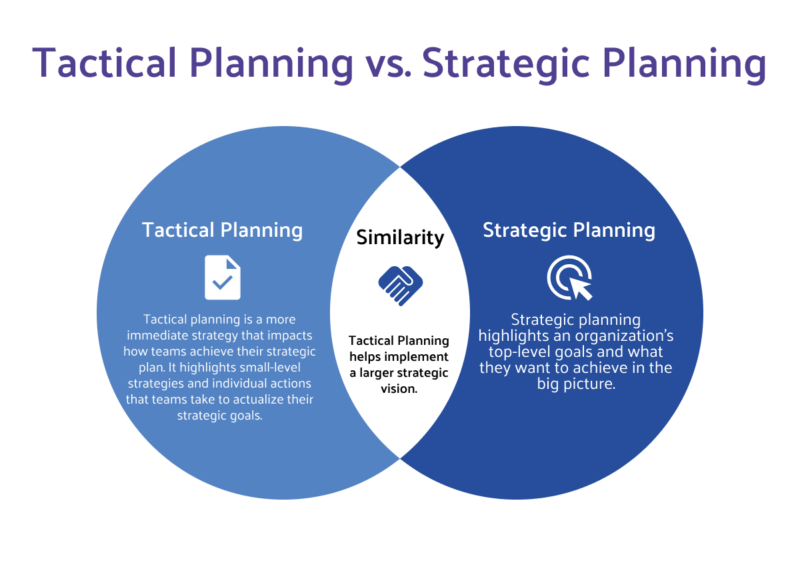

Executing a strategic plan takes careful consideration, planning, and prioritization. When outlining how to achieve overarching strategic objectives, tactical planning is a process that organizations use to help increase efficiency and reach their goals successfully. In this article, we will outline what tactical planning is, why it’s important, and its necessary elements.
Tactical planning is defined as the process of taking an overarching strategic plan and creating actionable short and medium-term timelines to achieve your goals. Tactical planning usually helps define goals at multiple levels and can help break down long-term strategic objectives into benchmarks that can be reached in smaller and more focused projects. Alignment is important for creating effective goals, and tactical planning is a key step to achieving alignment throughout a strategic vision.
As previously mentioned, tactical planning is usually utilized when an organization needs to formulate a plan of action to meet larger strategic objectives. This could be an immediate call to action or one that spans a couple of months; it just depends on the desired objectives. Because of this, tactical planning is a flexible strategy that organizations utilize when they need to break down a larger vision into tangible steps.
Tactical planning usually involves a couple of key steps, including creating goals, dividing responsibility, funneling resources, creating a timeline, and assigning specific tasks. Creating goals is a key part of the tactical planning process, and teams traditionally seek to create SMART goals to help fuel their success. Setting SMART goals allows organizations to increase efficiency and productivity for teams by creating clear, attainable goals for any size project. SMART goals stand for:
Tactical planning is not strictly used as an actionable prompt for strategic planning and can be applied in multiple other scenarios as well. Here are some of the ways that tactical planning can be utilized within an organization:

Tactical planning is a process that can be edited depending on the strategic plans being pursued by an organization, but it generally follows a similar set of steps when implemented correctly. Here are the main elements of tactical planning that your team can’t miss.
One of the most important parts of tactical planning is mapping goals accurately between strategic long-term goals and short-term objectives. For most organizations, this will entail creating a system of SMART goals to target objectives and provide a system of actionable tasks to achieve short-term goals and move toward long-term objectives. Because tactical planning is focused on linking strategic goals with achievable immediate actions, most of these goals will be structured to optimize immediate performance and create systems of action for current projects.
The goal-creation process should begin with the overarching strategic goals and should trickle down to creating projects that address these goals while also meeting customer needs. Goals need to be measurable to ensure they can be tracked throughout the process. Tracking goals is key to optimizing them and understanding if they’re meeting objectives. As defined by SMART goals, goals need a couple of items to be accurate and actionable. They need to be relevant to the overall objectives of the team, achievable to keep progress moving, and timely to create predictable and accurate project cycles. All of these elements help create informed and successful goals for your team to follow.
Tactics are the specific strategies and micro-strategies that your team uses to reach your goals. This involves the research, development, implementation, and quality assurance of any solution created as part of a larger goal. Implementing tactics for your team is a process of creating a small-scale strategy to achieve your goals through task implementation. Tactics will explain the strategy and targeting of specific tasks to come and will allow teams to reach their goals in the most efficient way possible.
One thing that’s important to emphasize when creating tactics for your goals is the KPIs that your team is monitoring. Tracking the right KPIs (key performance indicators) is critical to ensuring goals are accurately positioned to reach high-level strategic objectives, and these KPIs need to translate into the tactics of each team as well. Make sure that the KPIs of your strategic goals are reflected in your tactical strategy.
Once you have a solid tactical strategy set up to achieve your goals, you can focus on the actual tasks needed to achieve your goals. Tasks fall under a system of goals and describe the daily actions completed in order to accomplish larger sets of objectives. They are usually structured around the timelines of the goals to help teams finish projects on time and in a regular sequence.
For the daily operation of a team, tasks will be the most important regular touchpoint to make progress and move forward. They are crucial to create regular structure for teams. They’re emphasized here because they’re a critical touchpoint to link larger strategic goals to individual actions, and this connection is critical to ensure everything works in an aligned system.
When creating a tactical plan, resource allocation is important to perform the individual tasks in the plan, develop changes correctly, and make efficient progress. Resources don’t just refer to money; they can include materials, time, finances, team bandwidth, product details, equipment, and more. Each project will require a specific allocation of resources, and it’s up to the project management team to determine how to allocate resources between projects to ensure maximum efficiency.
Tactical planning requires a clear timeline to ensure everyone has clear and aligned expectations. Following deadlines, creating project boundaries, and forming a timeline for all tasks to finish within will provide teams with a solid cadence and clear priorities going forward. This helps eliminate miscommunication and can improve efficiency and work product for everyone. Timelines also give leadership a place to clarify priorities and communicate needs to an entire team. This makes them an essential element of tactical planning and a crucial place to create team alignment.
An important thing to remember with tactical planning is that not everything needs to boil down to the immediate tasks. Successful teams will always create forward-looking plans, and this requires a certain amount of flexibility to function correctly. When creating flexible plans, teams can have more reassurance and be prepared for something going wrong. If you don’t plan for potential roadblocks, you might panic when they inevitably arise. Make sure that your team is flexible and open to change along the way to ensure you’re ready to tackle any surprise challenge.
When creating tactical planning scenarios, there are a number of templates you can use. A very popular example within teams is the SWOT template . This is a popular brainstorming template that can also be used to effectively organize a tactical planning example. Using a SWOT template can help expose places an organization needs to focus and can be the inspiration behind a new tactical planning strategy. In order to better explain how tactical planning can be implemented, we outlined a couple of simple tactical planning examples to illustrate what a basic overview might look like.
Increase Enterprise Sales: An organization decides that it wants to shift focus to enterprise sales instead of B2C sales. This requires a different strategy to implement effectively. The tactical planning steps might look like this:
Strengthen Brand Positioning: Your business has a solid product offering, but you want to strengthen your brand positioning to increase visibility and credibility. This requires strategic repositioning within the ecosystem to evoke the right feelings in your users. Here’s what your tactical planning might look like:
Hire a New Development Team: As an effort to increase feature depth and product stickiness, you’re focusing on hiring a new development team to supplement product growth. Here’s what a tactical plan for the hiring process might entail:
Understand Strategic Objectives: The tactical planning process begins by understanding the overarching strategic objectives of the organization or department. These objectives provide the context for the tactical plans.
1. Identify Key Initiatives: Based on the strategic objectives, identify the key initiatives or projects that need to be undertaken. These initiatives should directly support the achievement of strategic goals.
2. Set Specific Goals: For each initiative, set specific and measurable goals. These goals should be clear, quantifiable, and time-bound. They act as benchmarks for success.
3. Resource Allocation: Determine the necessary resources, including budget, personnel, and technology, required to implement the initiatives successfully.
4. Create Action Plans: Develop detailed action plans that outline the tasks, responsibilities, timelines, and milestones for each initiative. These action plans help guide day-to-day operations.
5. Risk Assessment: Assess potential risks and challenges that could hinder the execution of the tactical plans. Create alternative plans or strategies to deal with these potential risks.
6. Monitor and Measure Progress: Continuously monitor and measure the progress of the tactical plans. Key performance indicators (KPIs) can be used to track success and make necessary adjustments as needed.
7. Communication and Alignment: Ensure that all stakeholders within the organization are aware of the tactical plans and how they contribute to the overall strategic objectives. Alignment and buy-in from team members are critical for successful implementation.
8. Regular Review and Adaptation: Tactical plans should be periodically reviewed and adapted as the business environment evolves or as new information becomes available. Flexibility is essential in responding to changing circumstances.
9. Execution: Finally, execute the plans according to the established timelines and guidelines. This involves coordinating resources, monitoring progress, and making adjustments as necessary to stay on course.
Tactical planning helps organizations bridge the gap between their long-term strategic vision and the day-to-day operations required to achieve their goals. It ensures that specific actions are taken to move the organization forward while allowing for adaptability and responsiveness in a dynamic business environment.
Tactical planning can make a difference for teams that are trying to implement their goals on a smaller scale. If your team is thinking about implementing a plan of action, but you aren’t sure if it will be beneficial, we’ve listed some of the biggest tactical planning advantages below.
Tactical planning and strategic planning are very often confused with one another, but they operate in completely different scopes. Below we’ve provided a simple and clear explanation of how the two are unique.
Strategic planning highlights an organization’s top-level goals and what they want to achieve in the big picture. This will encompass both their goals and their overall vision to create a picture of what they want to achieve in the future. When developing strategic plans, top-level management collaborates on reports and goals to facilitate alignment and accuracy in their vision. Strategic planning is traditionally done above tactical planning and will influence how tactical planning unfolds.
Tactical planning is a more immediate strategy that impacts how teams achieve their strategic plan. It highlights small-level strategies and individual actions that teams take to actualize their strategic goals. Overall, tactical planning emphasizes short-term actions to follow through on overall strategic plans.
Through this analysis, we can see that tactical and strategic planning are related but operate through entirely different scopes. Hopefully, this helps clear up the difference and allows your team to effectively facilitate both.
Setting SMART goals and formulating a plan of action is key to effective tactical planning and can be the difference for teams in achieving their goals. If this guide helped you, try taking a look at IdeaScale Whiteboard to see how collaboration can help formulate and execute tactical planning.